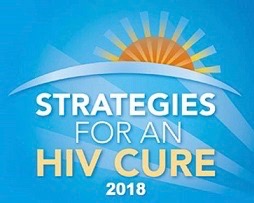
The 2018 NIH-sponsored Workshop on HIV Cure took place in Bethesda, Maryland from October 10–12, 2018. This bi-annual meeting covers a range of topics spanning basic and translational research, drug discovery and development and clinical research related to finding a cure for HIV infection—or long-term suppression off therapy.
The “Martin Delaney Collaboratory: Towards an HIV-1 Cure” NIH program aims at supporting new HIV cure research strategies encompassing key areas of basic, translational and clinical research. There are six Martin Delaney Collaboratories funded to advance the science of HIV cure/remission. Each Collaboratory provided a scientific update.
The I4C Collaboratory, led by Dan Barouch (Harvard University), John Mellors (Pittsburgh University), and Nelson Michael (U.S. Military HIV Research Program), focuses on developing combined immunologic approaches to reduce or control the HIV viral reservoir in people living with HIV, with the goal of achieving durable suppression. Two key strategies under investigation include therapeutic vaccines to augment immune surveillance and broadly neutralizing antibodies to maintain viral suppression. Several vaccine types are being pursued, including Ad26/MVA, Ad25/Env and peptide-pulsed dendritic cell vaccines. Many broadly neutralizing antibodies have been also advanced into clinical testing with possible complementarity of coverage.
The BEAT-HIV Collaboratory, led by Luis Montaner (University of Pennsylvania), tests combinations of novel immunotherapies in preclinical and clinical research. The Collaboratory has three main goals: 1) finding where and how HIV hides in the body, 2) making the immune system stronger against HIV, and 3) helping the body better fight the infection. The BEAT-HIV collaboratory will initiate the first combination gene therapy trial later this year. The BEAT-HIV collaboratory recently published important results related to the safety and efficacy of the antibody combination 10-1074 + BNC117. In one study, nine participants were able to maintain viral suppression off therapy for a median of 21 weeks. Another study reported an average reduction in HIV-1 viral load of 2.05 log10 copies per mL, which remained sustained for three months following one to three infusions of the antibodies.
The BELIEVE Collaboratory, led by Douglas Nixon and R. Brad Jones (Cornell University), aims at enhancing and improving immune responses to HIV via targeted antibodies, innate and adaptive cells, and combination of agents. Enhanced immunity strategies being investigated include immune effectors, immune augmentation and various targets for the HIV reservoirs.
CARE, the Collaboratory of AIDS Researchers for Eradication, led by David Margolis (University of North Carolina at Chapel Hill), focuses on developing, testing and validating novel latency-reversing agents, and developing approaches to clearing HIV infected cells. Immunologic approaches being investigated include expanded anti-HIV cytotoxic T cells (HXTCs), broadly neutralizing antibodies and dual-affinity retargeting molecules (DARTs).
The defeatHIV Collaboratory, led by Keith Jerome and Hans-Peter Kiem (Fred Hutchinson Cancer Research Center), focuses on advancing cell and gene therapy approaches towards an HIV cure. Multiple targets for anti-HIV gene therapy are under investigation and are moving forward in pre-clinical research development. A promising approach involves the use of chimeric antigen receptor (CAR) T cells that have had remarkable success in the treatment of certain leukemias.
The Delaney AIDS Research Enterprise (DARE) Collaboratory, led by Steven Deeks (University of California San Francisco), investigates combination approaches involving therapeutic vaccines, adjuvants, immune-modifying agents and sanctuary disruption. Notably, immune checkpoint blockers are being tested as potential biomarkers for the HIV reservoir. The DARE Collaboratory is trying to test new ways to deliver HIV therapeutic vaccines, including using cytomegalovirus (CMV) vector.
Additional highlight:
Boris Juelg provided a summary of the consensus workshop on analytical treatment interruptions (ATIs), held at the Ragon Institute in July 2018. The main purpose of the workshop was to produce a set of recommendations to facilitate the conduct of ATIs in a manner that could maximize the knowledge gained, while minimizing risks to study participants. Among the key outcomes were that ATIs are highly context dependent, and that there is no “one size fits all” guideline for when ATIs are appropriate. Workshop participants reached consensus on several risk mitigation strategies during ATI studies—including inclusion/exclusion criteria. There was some agreement that for certain study objectives, longer and higher viremia may need to be tolerated. There was consensus that the word “cure” should be avoided in informed consent forms of studies utilizing ATIs, and that a set of socio-behavioral and ethics questions should be included as part of ATI studies. Workshop organizers are working on a manuscript of key consensus viewpoints. This manuscript should be available in early 2019.
For more information, go to:
Meeting agenda:
Video cast Day 1: https://videocast.nih.gov/summary.asp?Live=28484&bhcp=1
Video cast Day 2: https://videocast.nih.gov/summary.asp?Live=28492&bhcp=1
Video cast Day 3: https://videocast.nih.gov/summary.asp?Live=28488&bhcp=1

